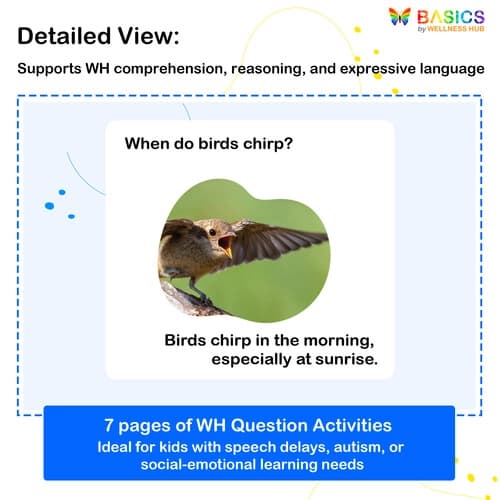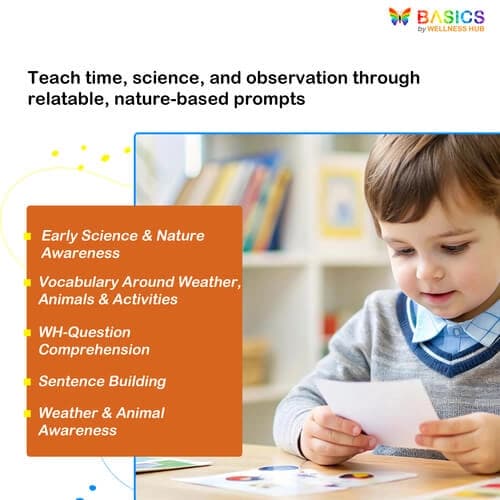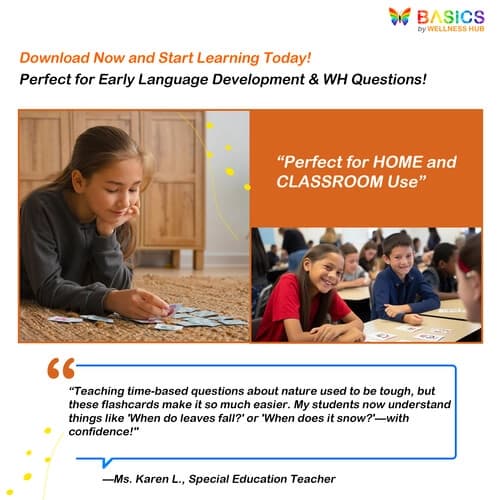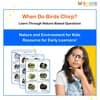
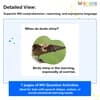


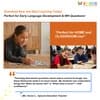
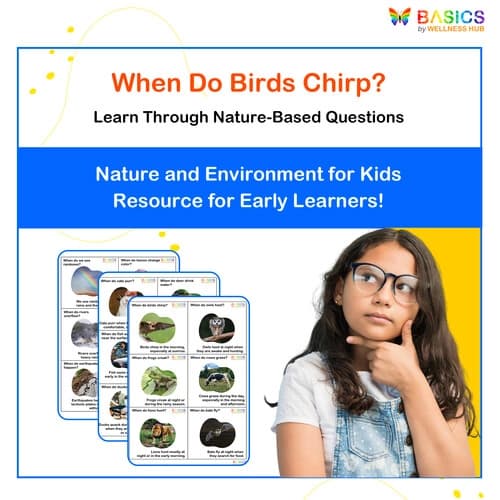
When Questions Flashcards – Nature and Environment for Kids (Printable PDF)
₹80
₹160
50% off
0 (0 ratings)
Grade Levels
Pre-K - Grade 2 (Ages 3-7)
Content Overview
Format: Printable PDF, Total Pages: 7, Features: 42 picture-based flashcards about nature, animals, and outdoor exploration
Pages from the Resource
Help kids answer “When” questions while exploring the natural world! This printable set includes 42 flashcards with engaging questions and answers like “When do birds chirp?” or “When do we see rainbows?” Ideal for building WH-question comprehension, vocabulary, and early science concepts through nature-based learning.
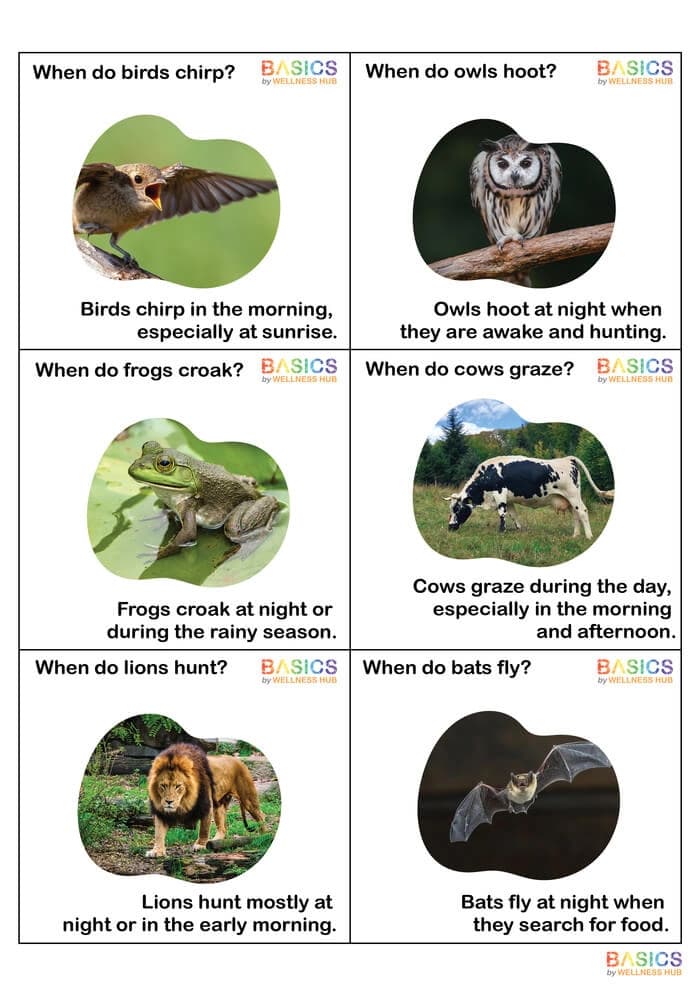
Page 1
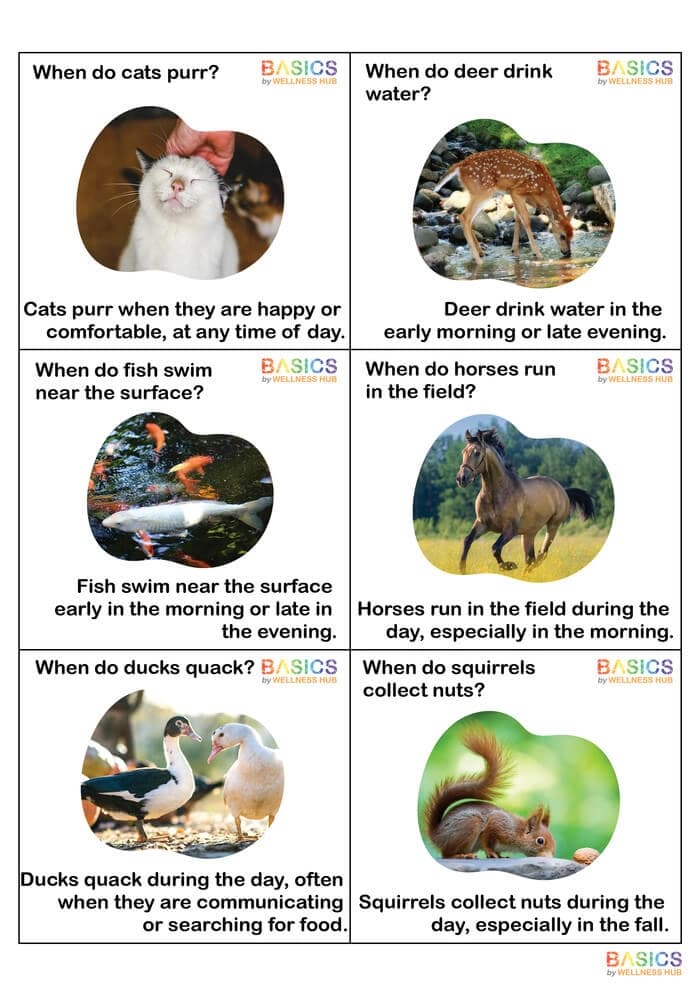
Page 2
What Users Say
0
0 ratings
5
0+
4
0+
3
0+
2
0+
1
0+
5 Stars
Product is Good to use.
1 year ago
Varsha Parent
Similar Products
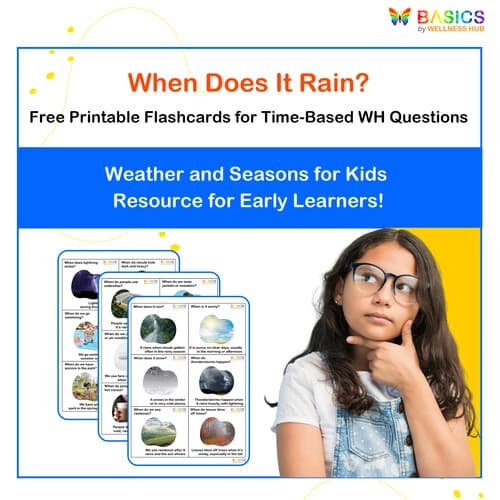
When Questions Flashcards – Weather and Seasons for Kids (Free Printable PDF)
FREE
₹160
50% off
4.9 (46 ratings)

Desert Animals Flashcards for Kids – Free Printable PDF
FREE
₹160
50% off
4.9 (50 ratings)

Fruits Flashcards for Kids: Free Printable PDF
FREE
₹160
50% off
4.7 (58 ratings)

Wild Animals Flashcards for Kids: Free Printable PDF
FREE
₹160
50% off
4.6 (45 ratings)

Water Animals Flashcards for Kids – Free Printable PDF
FREE
₹160
50% off
4.7 (46 ratings)
About the Product
✅ Introduction
Children are naturally curious about the world around them, especially nature—how birds sing, when it rains, or why we see rainbows. This printable flashcard set introduces children to “When” questions rooted in the beauty of the natural world, using real-world examples to teach time-based reasoning, language development, and early science concepts.
Each card presents a relatable question such as “When do birds chirp?” or “When do we go hiking?” followed by a simple, full-sentence answer and a supportive picture. Whether used at home, in therapy, or in the classroom, this nature-themed resource makes WH-question learning engaging, functional, and fun.
✅ Product Details
- Format: Printable PDF
- Total Pages: 7
- Flashcards Included: 42 cards (6 per page)
- Visuals: Bright, child-friendly pictures illustrating natural events and outdoor scenes
- Question Format: Each card includes a “When” question and a clear, developmentally appropriate answer
- Topics Covered:
- Animal behaviors (e.g., birds chirping, frogs croaking)
- Natural phenomena (e.g., rainbows, rainfall, sunset)
- Outdoor exploration (e.g., going to the park, hiking, stargazing)
✅ Educational Benefits
- WH-Question Comprehension: Strengthens the ability to understand and answer “When” questions using nature-based contexts
- Early Science Awareness: Introduces basic science and seasonal awareness (e.g., when animals are active, when weather changes occur)
- Time and Routine Concepts: Builds understanding of time-specific activities like sunrise, sunset, seasonal hikes, or rainbows
- Vocabulary Expansion: Reinforces nature-related vocabulary and connects words to images
- Functional Language Building: Encourages use of complete, meaningful sentences in response to questions
- Inclusive Learning Support: Helpful for children with speech delays, autism, ADHD, and other learning differences, using visuals and predictable structure
✅ Instructions for Use
- Print and Prepare the Flashcards
- Download the PDF and print on standard or sturdy paper.
- Laminate if using frequently in therapy or classroom environments.
- Introduce Cards by Theme
- Start with a specific theme like animal behaviors or outdoor activities.
- Example: Show “When do birds chirp?” and read the answer aloud together.
- Use Cards During Related Activities
- Bring out cards while engaging with nature:
- During a nature walk, introduce “When do we go hiking?”
- After a rainy day, show “When do we see rainbows?”
✅ Reinforces learning through lived experiences.
- Bring out cards while engaging with nature:
- Prompt Independent Responses
- Read the question aloud and let the child try to complete the sentence.
- Use prompts or sentence starters as needed:
“We see rainbows when…”
- Use as Conversation Starters
- Extend each question into a discussion:
- “When do you like going outside?”
- “What sounds do birds make in the morning?”
- Extend each question into a discussion:
- Incorporate into Thematic Learning or Science Lessons
- Use alongside units on weather, seasons, animals, or the environment.
✅ Great for blending speech and academic goals.
- Use alongside units on weather, seasons, animals, or the environment.
- Sort and Categorize
- Ask children to group flashcards into categories such as “animal behavior,” “weather,” and “outdoor activities.”
✅ Builds categorization and critical thinking.
- Ask children to group flashcards into categories such as “animal behavior,” “weather,” and “outdoor activities.”
✅ Activities Using the Resource
These nature-themed “When” flashcards are ideal for combining language development with environmental awareness. Here are a variety of engaging, hands-on, and educational activities you can use with this resource:
1. Nature-Themed Q&A Time
- Show a flashcard and ask the child to answer the “When” question.
- Example: “When do we see rainbows?”
- Child responds: “We see rainbows after it rains and the sun shines.”
✅ Builds full-sentence responses and WH comprehension.
2. Outdoor Learning Integration
- Use cards during outdoor walks, park visits, or nature observation.
- Example: During a morning walk, ask: “When do birds chirp?”
✅ Makes learning contextual and real-world.
- Example: During a morning walk, ask: “When do birds chirp?”
3. Sorting and Categorization Game
- Mix all cards and ask the child to sort them into categories:
- Animal Behaviors
- Natural Phenomena
- Outdoor Activities
✅ Encourages cognitive flexibility and reasoning.
4. Cause and Effect Extensions
- Use the cards to spark cause-effect questions:
- “Why do birds chirp in the morning?”
- “What happens when it rains?”
✅ Helps develop critical thinking and deeper understanding.
5. Storytelling Prompts
- Choose 3–4 flashcards and ask the child to make up a nature-themed story.
- Example: “I saw a rainbow after the rain, then I went hiking and heard birds chirping.”
✅ Strengthens sequencing and expressive language.
- Example: “I saw a rainbow after the rain, then I went hiking and heard birds chirping.”
6. Draw What You See
- Show a card and ask the child to draw what is happening in the image or what happens after.
✅ Supports visual expression and vocabulary recall.
FAQs
Q1: What age group is this best for?
A1: This resource is ideal for children aged 3 to 7, or Pre-K to Grade 2.
Q2: Can it be used for children with special needs?
A2: Yes! The cards are designed to support children with autism, speech delays, ADHD, and other learning challenges using structured WH-question prompts and visual support.
Q3: What makes this set different from other WH resources?
A3: It focuses specifically on nature and the environment, using realistic, relatable scenarios that combine language learning with science concepts.
Q4: How many flashcards are included?
A4: There are 42 illustrated flashcards across 7 pages, with 6 questions per page.
Q5: Can I use this during classroom or therapy sessions?
A5: Absolutely. These cards are great for circle time, individual speech therapy, science centers, or home-based learning.
Q6: Is this resource suitable for thematic teaching?
A6: Yes! It fits perfectly into units on weather, seasons, animals, habitats, or nature walks.
✅ Usage Rights and Restrictions
- You May:
- Use this resource for personal, classroom, or therapy use
- Print, laminate, and reuse it across different sessions
- Share the original download link with colleagues, educators, or families
- You May Not:
- Resell or distribute the file commercially
- Upload it to other websites, platforms, or resource repositories
- Alter the content for redistribution under another brand or format
If you'd like to share it with others, please link to the official download page to support the creators.
✅ Conclusion
The When Questions Flashcards – Nature and Environment resource brings together language learning, real-world thinking, and environmental awareness in one beautiful printable set. With questions that children naturally ask—like “When do frogs croak?” or “When do we go hiking?”—this tool makes WH-question practice immersive, relatable, and meaningful.
Whether you're a parent encouraging conversation at home, a therapist targeting WH-question goals, or a teacher bringing nature into your classroom, these cards are a flexible and engaging addition to your toolkit.
